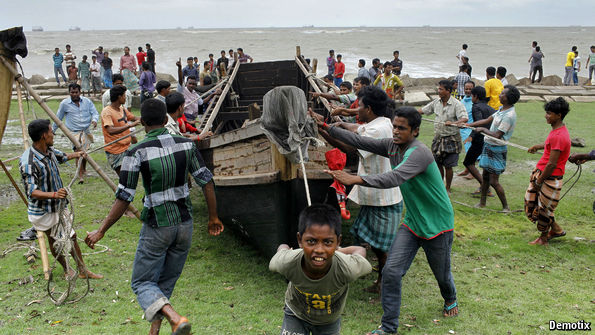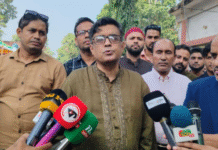How farmers in poor countries are responding to climate change
IN THE BRACKISH coastal districts of southern Bangladesh, weather can be measured in centimetres. Women in Bujbunia, 140km (about 90 miles) south of Dhaka, hold their hands at knee height to show how deeply the village flooded during the most recent big cyclonic storm. Aila swept northward through the Bay of Bengal and hit Bangladesh in May 2009. The country had seen much bigger weather events; in 1991 a huge cyclone killed about 140,000 people. Still, Aila’s storm surge brought enough seawater to inundate villages and wipe out rice crops. The inhabitants of Bujbunia still wince when they recall how hungry they were afterwards.
Few countries of any size are more gravely threatened by climate change than Bangladesh (which has more than 110m people). Sarder Shafiqul Alam of the International Centre for Climate Change and Development in Dhaka checks off the many hazards. North-west Bangladesh seems to be turning drier. In the north-east and central parts of the country, flooding is a growing danger. The south and east are vulnerable to cyclones, which will probably intensify as the planet heats up (the higher the temperature, the more energy in the weather system). The south is also becoming saltier, partly because the sea is rising and partly because many farmers are inundating their fields with seawater so they can grow shrimp.
To counter the most spectacular threat to human life, Bangladesh’s government has built several thousand cyclone shelters—at best, sturdy buildings sitting atop pillars of reinforced concrete, which in normal times are often used as schools. One new shelter a few kilometres from Bujbunia could accommodate more than 1,000 people if they were to press closely together, and might even hold a few hundred cows on the ground floor. Women and children will rush there if a big cyclone threatens; men will head for the nearest brick-built mosque.
Farmers are also preparing for storm surges in a humbler way. Scooping up greyish mud, they build plinths up to a metre high. Levelled and packed down, these become the floors of their homes; walls and roofs are made of palm fronds, bamboo and corrugated iron. The aim is to build the plinth higher than the flood waters will reach, to prevent the family’s food and possessions being swept away. Even stoves would be destroyed; they are only made of earth.
Whereas the global attempt to avert global warming by cutting emissions is not exactly racing forward, adaptation to climate change is well under way. Between 1993 and 2009 the proportion of American households with air-conditioning rose from 68% to 87%. Californian cities are coping with an epic four-year drought, which may have been exacerbated by climate change, by buying water rights from farmers and recycling more waste water. San Diego is building an expensive desalination plant. In sub-Saharan Africa many farmers are diversifying from growing wheat to sorghum and other crops. Few of the people making such adjustments are thinking explicitly about global warming; they are simply trying to make themselves more comfortable and secure. Yet their actions add up to the most profound and intelligent response to climate change so far.
Bringing down emissions of greenhouse gases asks a good deal of people, not least that they accept the science of climate change. It requires them to make sacrifices today so that future generations will suffer less, and to weigh the needs of people who are living far away. Adaptation requires none of these things. “Because of the free-rider problem, each of us has very weak incentives to alter our behaviour,” says Matthew Kahn, of the University of California, Los Angeles. “But we have very strong incentives to respond to whatever the climate throws at us.”
Bewket Amdu, Azemeraw Ayehu and Andent Deressa have surveyed almost 400 villagers in the upper catchment of the Blue Nile in Ethiopia and found that almost everybody believes temperatures are rising. Most villagers also think less rain is falling, although some are convinced the weather has become wetter. They have responded by tweaking their farming techniques. The villagers now plant potatoes two to three weeks later than they used to and harvest them a week earlier. The growing seasons for wheat and barley have also contracted by about a month. Yields are lower, but that is preferable to losing an entire crop to flooding or drought.
To save farmers from having to make such dismal trade-offs, laboratories in Africa and elsewhere are developing crops that can survive more extreme weather. One poetically nicknamed innovation is “scuba rice”, which can endure being submerged for up to two weeks. BRAC, a large NGO based in Bangladesh, is training farmers to switch from ordinary rice to salt-tolerant varieties, or to grow sunflowers instead. It has also pioneered a combination of agriculture and aquaculture. During the monsoon season farmers raise freshwater fish in their flooded fields. As the ground dries out, the fish move to a pool at one end, freeing the remainder of the field for rice-growing.

Adaptations like these are conservative. They enable farmers to keep living in the same place and working the same fields, albeit growing different things. The hope is that higher agricultural productivity will protect people against climate shocks and also keep them from encroaching on forests. The rate of deforestation has slowed around the world in the past few decades, mostly because of better policing in Brazil, but last decade it still accounted for about 12% of global greenhouse-gas emissions.
Yet poor farmers will continue to live dangerous, precarious lives. Homes built of bamboo and corrugated iron in southern Bangladesh will not survive a really big cyclone, no matter how high they are raised off the ground. And cyclones are far from the only hazard in the region. To cook food, the farmers who live in these flimsy homes burn wood and animal dung, and thereby gradually poison themselves. Some of the water wells are contaminated not just with salt but with arsenic.
Urban idyll
To protect themselves against these diverse dangers, the farmers of southern Bangladesh need to make drastic changes. They are doing that by investing in their children’s education. In a secondary school in the settlement of Sreefaltola, a class of eighth-graders, mostly farmers’ children, shout out their plans for the future. Almost every one of them aspires to be an electrical engineer or a doctor, or at least to find a job in a nearby city. Not all will succeed; many will probably stay in farming. But those who make it might be able to move their parents out of one of the most hazardous places in Asia.
This is not normally what is meant by adaptation to climate change. All the same, it is the most effective method of adaptation in Bangladesh, says Mr Alam. Some have taken it even further. In the village of Gobindapur, a grand new house is being built, two storeys high and made of solid brick. It belongs to Reshma Begum, an imperious woman in a pink sari. Clutching two mobile phones, she complains that it is becoming increasingly hard to find domestic workers now that so many young women in the village are running small businesses. Some of her income comes from a son who works in Malaysia.
Migrations such as these are beginning to show up in official statistics. Between 2001 and 2011 the population of Barisal division in southern Bangladesh fell slightly, even as numbers in the country as a whole went up. Within the district, people moved from the countryside to cities, so that Barisal’s rural population dropped from 1.96m to 1.81m. By removing people from the most flood-prone areas, urbanisation may be doing as much to preserve life as any number of cyclone shelters.
A decade ago adaptation was almost taboo in international discussions about climate change, because it was believed to distract attention from the task of stopping global warming altogether. Now both are recognised as important. Rich countries are trying to rustle up $100 billion a year by 2020 to help poor countries cope with climate change—a bribe to keep them coming back to the climate talks, to be sure, but also a welcome sign of changing priorities. Even China is chipping in.
It is not yet clear whether the money will be spent on better crops and fertilisers or on solar panels and other green-energy schemes that will help poor countries hold down their greenhouse-gas emissions. Britain, which spends an unusually large share of its budget on foreign aid, suggested in September that its contribution to the Green Climate Fund would be divided evenly between those two things.
That is the wrong balance. Solar panels are nice to have; many Bangladeshi farmers already possess small ones which they use for charging mobile phones and powering a couple of light bulbs. But these are no substitute for reliable electrical power, and there are plenty of more important things. Diverting money that would otherwise be spent on health and sanitation to expensive forms of clean energy will make it harder, not easier, for the world’s poorest people to cope with climate change.
Source: The Economist










